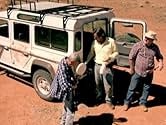IMDb RATING
8.1/10
2.5K
YOUR RATING
Re-enactments of real-life tales of human survival against the savage elements, dangerous climates and physical hazards.Re-enactments of real-life tales of human survival against the savage elements, dangerous climates and physical hazards.Re-enactments of real-life tales of human survival against the savage elements, dangerous climates and physical hazards.
Browse episodes
Featured reviews
Amazing true stories of often simple mistakes that lead to a fight for survival in some of the most perilous places on earth. The situations are really well re-enacted with excellent commentary and interviews with the actual people envolved. Often these stories are quite harrowing and always emotional, as they really do come extremely close to death and in some of the more distressing cases, not everyone makes it out alive. This also works as an educational series on the precautions everyone should take when venturing into any kind of wilderness.
I loved this series, so sorry they quit making them in 2006. I am an avid outdoorsman and have learned lots from the series, how to avoid getting into trouble.
I changed from watching true crime where people die horribly at the end to watching survival stories and it improved my mood and perspective on life. As someone dealing with on and off depression, these stories are really inspiring. Please bring this back.
This series is so well produced.
Not overdone, the narrator, the music, the shots, the actors, learning to know the person to whom that happened.
It's a breath of fresh air.
I'm interested in outdoor survival, so I was naturally attracted to the title of this series. I started watching the episodes hoping to learn something from them.
What I took out from this series was the following:
1. When you're lost, keep moving. Although there're no guarantee of survival, all the people who survived in this series kept on moving searching for help.
2. Always carry container to carry water.
3. Have plastic sheets and strings to form a shelter from wind and sun, they can also help to collect water.
4. Carry something to filter water. Having real outdoor water filter would be ideal.
5. Carry GPS, and if possible a satellite phone especially if you're going out to the remote areas of wilderness. Keep them in waterproof plastic bags. Going without it is playing Russian Roulette with fate.
6. Carry means to start fire.
7. Carry 3 days worth of food each day worth about 1800 calories. Each Day only weighs about a pound and a half, so it wouldn't be so heavy.
8. Carry a mosquito net in tropics and insect repellent to cover your body.
9. Of course know where you are starting from. Carry a compass and a map of the area.
10. Carry a basic survival kit and first aid.
11. Optional, carry a tent and sleeping bag.
12 Wear a comfortable shoes. Carry a windbreaker, and a hat even if the day is warm.
I've tallied up all these equipment and I found that I can come up with a pack that weighs well below 10 lbs. That's not much of a burden in contrast to the drastic increase in survival possibility.
So the program was not only interesting, but inspirational, and educational as well.
Highly Recommended.
What I took out from this series was the following:
1. When you're lost, keep moving. Although there're no guarantee of survival, all the people who survived in this series kept on moving searching for help.
2. Always carry container to carry water.
3. Have plastic sheets and strings to form a shelter from wind and sun, they can also help to collect water.
4. Carry something to filter water. Having real outdoor water filter would be ideal.
5. Carry GPS, and if possible a satellite phone especially if you're going out to the remote areas of wilderness. Keep them in waterproof plastic bags. Going without it is playing Russian Roulette with fate.
6. Carry means to start fire.
7. Carry 3 days worth of food each day worth about 1800 calories. Each Day only weighs about a pound and a half, so it wouldn't be so heavy.
8. Carry a mosquito net in tropics and insect repellent to cover your body.
9. Of course know where you are starting from. Carry a compass and a map of the area.
10. Carry a basic survival kit and first aid.
11. Optional, carry a tent and sleeping bag.
12 Wear a comfortable shoes. Carry a windbreaker, and a hat even if the day is warm.
I've tallied up all these equipment and I found that I can come up with a pack that weighs well below 10 lbs. That's not much of a burden in contrast to the drastic increase in survival possibility.
So the program was not only interesting, but inspirational, and educational as well.
Highly Recommended.
Did you know
- ConnectionsReferenced in The Tonight Show with Jay Leno: Episode #20.17 (2011)
- How many seasons does I Shouldn't Be Alive have?Powered by Alexa
Details
- Release date
- Countries of origin
- Official sites
- Language
- Also known as
- I Shouldn't Be Alive
- Production companies
- See more company credits at IMDbPro
- Runtime1 hour
- Color
Contribute to this page
Suggest an edit or add missing content

Top Gap
By what name was Je ne devrais pas être en vie (2005) officially released in India in English?
Answer
































